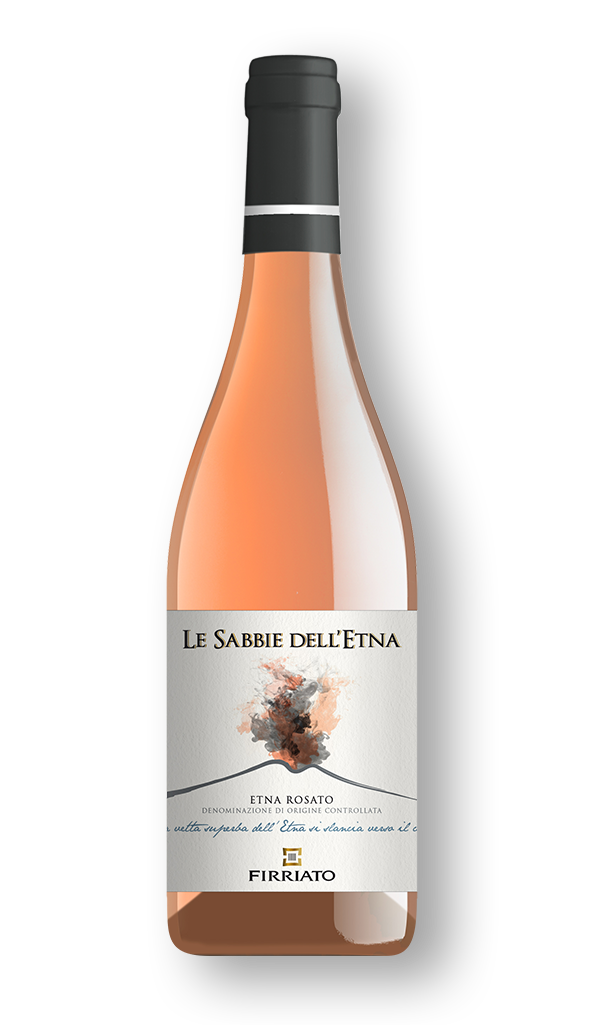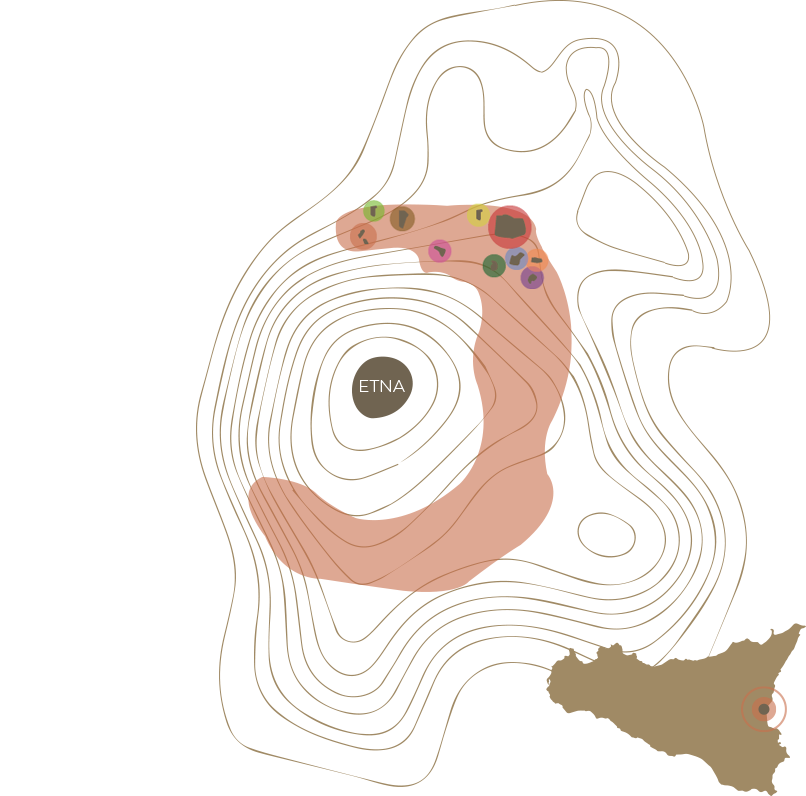
The wines obtained from Nerello Mascalese have a great variability in organoleptic characteristics depending on the Etna climate of origin of the grapes. Fruit of the union of several districts, Le Sabbie dell’Etna rosé is a pure vinification of this elegant vine, historically linked to the territory of the volcano. In line with the winemaking tradition of Etna, the grapes are subjected to a short maceration, to enhance the polyphenolic framework and preserve the varietal aromas of the grapes which range from delicate floral notes to hints of freshly ripe fruit. In the mouth there is a lot of balance and discreet persistence.

The wines obtained from Nerello Mascalese have a great variability in organoleptic characteristics depending on the Etna climate of origin of the grapes. Fruit of the union of several districts, Le Sabbie dell’Etna rosé is a pure vinification of this elegant vine, historically linked to the territory of the volcano. In line with the winemaking tradition of Etna, the grapes are subjected to a short maceration, to enhance the polyphenolic framework and preserve the varietal aromas of the grapes which range from delicate floral notes to hints of freshly ripe fruit. In the mouth there is a lot of balance and discreet persistence.
The microbiological and microchemical nature of lava flows differs greatly in its concentration of elements, not only in correspondence with a specific time band during which the magmatic activity took place, but also functionally in a specific area of the volcano affected by the eruptive phenomena. From this arises a very varied pedological picture and consequently a very varied supply of microelements, which both in viticulture and in oenology, ensures a multiple reading of the same Terroir to which it belongs. This means that it is possible that the same vine can give rise to completely different wines depending on the areas, better called and known as, “contrade” where the vineyards are located. The company’s vineyards are spread over 12 Contrade, with very different soil and climate characteristics that allow it to support a varied and always excellent production.

Castiglione di Sicilia - Randazzo
590-720 mt s.l.m.
North/North East
On the north-eastern side of the volcano, plant growth was characterized by a spring with a mild climate and little rain, followed by an unusually dry summer. These conditions favored excellent ripening of the grapes on Etna. The harvest began in mid-August for the international varieties grown near the sea and subsequently in mid-September on Etna with the harvest of Carricante and Nerello Mascalese for the production of rosé wines. The harvest period for red grapes was particularly long, starting early and ending towards the end of October with the Nerello Mascalese on Etna, thanks also to the 75% reduction in normal rainfall in September and October. As for Nerello Mascalese, it was an exceptional season for this vine on Etna. The limited rainfall during the ripening phase allowed for gradual and uniform maturation, similar to the best vintages. Nerello Mascalese has reached optimal phenological ripeness and the results promise to be extremely promising.
The 2021 harvest, after a mild spring, the sirocco showed its strength which, together with the decrease in rainfall, brought the harvest forward by about a week.
Thanks above all to the altitude, the exposure to the northern winds and the temperature range, there was a slight drop in production, but with an excellent quality of the grapes. The Nerello Mascalese harvest for the rosé took place in the first ten days of October. The wine has a delicate pink color, excellent acidity and an excellent balance between freshness and minerality.
The 2020 harvest on the north-eastern side of the volcano was regular, thanks to a climatic trend which recorded temperatures below the seasonal average (the only exception being the first ten days of August) and abundant rainfall which slightly postponed the maturation phase and collection.
The temperature variations - particularly accentuated, especially in the spring period - then determined a particularly high quality of the grapes, guaranteeing the wines intense and complex aromatic profiles. The Nerello Mascalese grapes, harvested in the first week of October, recorded a slower maturation and a good accumulation of aromatic substances.
The wine has a delicate pink color, notes of pomegranate and grapefruit on the nose, with excellent acidity and an excellent balance between freshness and minerality.
The 2019 vintage is generally affected by the colder and rainier climate trend compared to the averages of recent years. Temperatures were below the seasonal average during the flowering period and favorable climatic conditions were also recorded during ripening. The vegetative development of the plants was optimal, with perfectly functioning foliage, and a reduction in the average weight of the bunch which favored an increase in the average quality. During the ripening process, an increase in the level of sugars and the component of aroma precursors in the grapes was recorded thanks to the strong temperature variations between day and night. This evidence attributes to the vintage characteristics of excellent balance between the olfactory (aromas) and gustatory components (alcohol/freshness ratio).
The Nerello Mascalese grapes recorded a slower maturation and enjoyed significant temperature variations between day and night, favoring the accumulation of aromatic substances.
Harvesting operations began with an average delay of 8-10 days compared to the previous year.
The wine has a pale pink colour, notes of grapefruit and wisteria on the nose, and on the palate it shows excellent acidity and an excellent balance between freshness and minerality.
The climatic trend of the first months of 2018 was characterized by a mild winter and a spring with average temperatures. The summer, on the contrary, was characterized by rain and bad weather. Precipitation was more abundant and particularly concentrated in June, the wettest month of the last thirty years, according to regional averages. Despite the early summer rains, the Etna vineyards benefited from favorable climatic conditions, preserving the grapes in the most delicate stages of fruit development and maturation. The month of September recorded a slight increase in humidity and minimum temperatures compared to last year, but without ever causing particular phytosanitary problems. Overall, vegetative-productive development was regular, with the plants regaining better vigor, restoring production potentials that had lowered the previous year due to significant thermal and water stress. On Etna the harvest of Nerello Mascalese began between the first and second ten days of October. The ripening of the grapes was accompanied by the good climate, the temperature variations between day and night favored the accumulation of aromatic substances and a correct relationship between sugars and acidity, which enhanced the flavor and the typical varietal notes of Nerello Mascalese. In the context of the red varieties intended for the production of rosés, these characteristics suggest a wine of great aromatic finesse.
On the north-eastern side of the volcano, plant growth was characterized by a spring with a mild climate and little rain, followed by an unusually dry summer. These conditions favored excellent ripening of the grapes on Etna. The harvest began in mid-August for the international varieties grown near the sea and subsequently in mid-September on Etna with the harvest of Carricante and Nerello Mascalese for the production of rosé wines. The harvest period for red grapes was particularly long, starting early and ending towards the end of October with the Nerello Mascalese on Etna, thanks also to the 75% reduction in normal rainfall in September and October. As for Nerello Mascalese, it was an exceptional season for this vine on Etna. The limited rainfall during the ripening phase allowed for gradual and uniform maturation, similar to the best vintages. Nerello Mascalese has reached optimal phenological ripeness and the results promise to be extremely promising.
The 2021 harvest, after a mild spring, the sirocco showed its strength which, together with the decrease in rainfall, brought the harvest forward by about a week.
Thanks above all to the altitude, the exposure to the northern winds and the temperature range, there was a slight drop in production, but with an excellent quality of the grapes. The Nerello Mascalese harvest for the rosé took place in the first ten days of October. The wine has a delicate pink color, excellent acidity and an excellent balance between freshness and minerality.
The 2020 harvest on the north-eastern side of the volcano was regular, thanks to a climatic trend which recorded temperatures below the seasonal average (the only exception being the first ten days of August) and abundant rainfall which slightly postponed the maturation phase and collection.
The temperature variations - particularly accentuated, especially in the spring period - then determined a particularly high quality of the grapes, guaranteeing the wines intense and complex aromatic profiles. The Nerello Mascalese grapes, harvested in the first week of October, recorded a slower maturation and a good accumulation of aromatic substances.
The wine has a delicate pink color, notes of pomegranate and grapefruit on the nose, with excellent acidity and an excellent balance between freshness and minerality.
The 2019 vintage is generally affected by the colder and rainier climate trend compared to the averages of recent years. Temperatures were below the seasonal average during the flowering period and favorable climatic conditions were also recorded during ripening. The vegetative development of the plants was optimal, with perfectly functioning foliage, and a reduction in the average weight of the bunch which favored an increase in the average quality. During the ripening process, an increase in the level of sugars and the component of aroma precursors in the grapes was recorded thanks to the strong temperature variations between day and night. This evidence attributes to the vintage characteristics of excellent balance between the olfactory (aromas) and gustatory components (alcohol/freshness ratio).
The Nerello Mascalese grapes recorded a slower maturation and enjoyed significant temperature variations between day and night, favoring the accumulation of aromatic substances.
Harvesting operations began with an average delay of 8-10 days compared to the previous year.
The wine has a pale pink colour, notes of grapefruit and wisteria on the nose, and on the palate it shows excellent acidity and an excellent balance between freshness and minerality.
The climatic trend of the first months of 2018 was characterized by a mild winter and a spring with average temperatures. The summer, on the contrary, was characterized by rain and bad weather. Precipitation was more abundant and particularly concentrated in June, the wettest month of the last thirty years, according to regional averages. Despite the early summer rains, the Etna vineyards benefited from favorable climatic conditions, preserving the grapes in the most delicate stages of fruit development and maturation. The month of September recorded a slight increase in humidity and minimum temperatures compared to last year, but without ever causing particular phytosanitary problems. Overall, vegetative-productive development was regular, with the plants regaining better vigor, restoring production potentials that had lowered the previous year due to significant thermal and water stress. On Etna the harvest of Nerello Mascalese began between the first and second ten days of October. The ripening of the grapes was accompanied by the good climate, the temperature variations between day and night favored the accumulation of aromatic substances and a correct relationship between sugars and acidity, which enhanced the flavor and the typical varietal notes of Nerello Mascalese. In the context of the red varieties intended for the production of rosés, these characteristics suggest a wine of great aromatic finesse.
The harvesting of the nerello bunches is carried out manually during the first ten days of October. The grapes coming from multiple districts are transferred to the cellar. Here, the pressed grapes are subjected to a film maceration of a few hours and the must fermented, at controlled temperatures, in steel tanks. The refinement on noble lees lasts approximately 3 months in stainless steel tanks with periodic agitation. Once bottled, the wine rests another three months in the bottle to harmonize.

Delicate pink color.

Refined fragrant aroma with hints of raspberry and pomegranate.

Harmonious, with pleasant freshness, mineral with a long and persistent finish. Elegant, refined and complex, a wine that reflects the territorial characteristics of origin.


Ogni bottiglia di Signum Aetnae è conservata all’interno di un sofisticato cofanetto in legno serigrafato, uno scrigno che conferisce un tocco di lusso e raffinatezza al pezzo da collezione. Il cofanetto in legno è realizzato con maestria artigianale e rappresenta un elemento distintivo del packaging. La sua superficie è decorata con un motivo serigrafato di alta qualità che richiama l’identità del vino Signum Aetnae e dell’azienda Firriato.
All’interno del cofanetto, la bottiglia di Signum Aetnae è avvolta con cura in una delicata carta velina, che porta il logo del marchio e un sigillo di autenticità. Questo strato di carta protegge la bottiglia durante il trasporto e contribuisce a creare un’esperienza di apertura memorabile.
All’interno della confezione è presente un pieghevole informativo. Il pieghevole contiene dettagliate istruzioni sull’NFT (Non-Fungible Token) associato al vino Signum Aetnae. Spiega come accedere e godere di contenuti digitali esclusivi tramite l’uso dell’NFT, offrendo un’esperienza unica e coinvolgente per gli appassionati del vino.
All’interno del cofanetto, la bottiglia di Signum Aetnae è avvolta con cura in una delicata carta velina, che porta il logo del marchio e un sigillo di autenticità. Questo strato di carta protegge la bottiglia durante il trasporto e contribuisce a creare un’esperienza di apertura memorabile.
All’interno della confezione è presente un pieghevole informativo. Il pieghevole contiene dettagliate istruzioni sull’NFT (Non-Fungible Token) associato al vino Signum Aetnae. Spiega come accedere e godere di contenuti digitali esclusivi tramite l’uso dell’NFT, offrendo un’esperienza unica e coinvolgente per gli appassionati del vino.
All’interno del cofanetto, la bottiglia di Signum Aetnae è avvolta con cura in una delicata carta velina, che porta il logo del marchio e un sigillo di autenticità. Questo strato di carta protegge la bottiglia durante il trasporto e contribuisce a creare un’esperienza di apertura memorabile.
All’interno della confezione è presente un pieghevole informativo. Il pieghevole contiene dettagliate istruzioni sull’NFT (Non-Fungible Token) associato al vino Signum Aetnae. Spiega come accedere e godere di contenuti digitali esclusivi tramite l’uso dell’NFT, offrendo un’esperienza unica e coinvolgente per gli appassionati del vino.
Ogni bottiglia di Signum Aetnae è accompagnata da un sofisticato cofanetto in legno serigrafato, che aggiunge un tocco di lusso e raffinatezza.
Il cofanetto in legno è realizzato con maestria artigianale e rappresenta un elemento distintivo del packaging. La sua superficie è decorata con un motivo serigrafato di alta qualità che richiama l’identità del vino Signum Aetnae e dell’azienda Firriato.